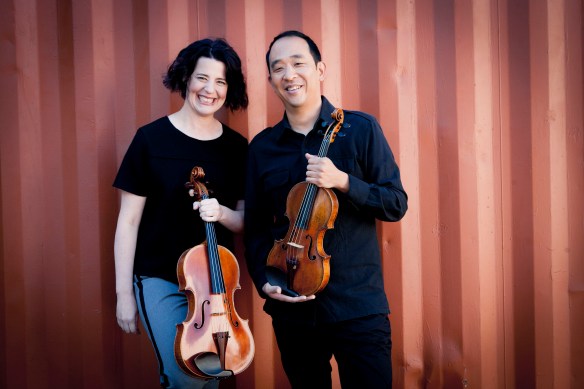by Jill Kimball

We live in a world where musical groups of every genre often craft signature sounds in order to make themselves more marketable. That’s all well and good for those who find one band’s sound and fall in love with it. But for those of us who prefer unpredictable music, it gets monotonous.
If you fall into the latter group, you probably appreciate the rare but always exciting cross-genre partnership—that glorious moment when two musical groups from different realms team up and produce something truly original. Sometimes it happens with Sufjan Stevens and yMusic. Other times, genres cross within the same family, as has happened with classical pianist Jeffrey Kahane and his more indie-inclined son, Gabriel.
This time around, the collaboration is a jointly-produced full album by the Chicago-based chamber collective Ensemble Dal Niente and the San Francisco avant-rock band Deerhoof. The two groups had an unlikely meeting in 2012 and found common musical ground immediately…so together they set to work on a recording project with Brazilian-American composer Marcos Balter. The result is an album that is by turns ambient and avant-garde, rocking and bebop-ing, lilting and crazed…in a good way.

Deerhoof.
The centerpiece of the album is Balter’s “MeltDown Upshot,” an incredible mashup of musical genres from across the globe. In other hands, this piece might sound overwhelming, but Deerhoof and Dal Niente are just chill enough to make it work.
The first two movements of “MeltDown Upshot” could be classified as ambient, but don’t mistake the word “ambient” for “boring.” The dreamy opening, “Credo,” spills seamlessly into “Parallel Spaces,” still floaty but with a tinge of sinister foreshadowing. “Ready,” with its frenetic Chick Corea-like jazziness, erratic meter and hazy lyrics (“I dream of sound in color / I dream of light in sounds”) is a sonic outlier in this piece and seems to represent the meltdown at its manic climax. A more organized mania comes in “True-False,” a fast-paced, string-plucking homage to Philip Glass-style repetition. The piece calms down again with “Home,” a delightfully indie take on João Gilberto’s Brazilian bossa nova. The last two movements take us back to the strange, dreamy vibes of the beginning. The sixth movement, “Cherubim,” is the clear highlight of the piece, somehow gathering all of Balter’s jazz, pop, rock and avant-garde influences together into three minutes of pure indie-rock bliss. With its driving percussion, earnest and unpolished vocals and wholly unique instrumentation, I have no doubt university radio hosts all over the country will be clamoring to get their hands on the single.

Ensemble Dal Niente.
Balter’s other piece on the album, “Pois Que Nada Que Dure, Ou Que Durando,” is set to text by Ricardo Reis (one of the many pseudonyms of Portuguese poet Fernando Pessoa). It’s a simultaneously gloomy and carefree ode to the transience of life, a proclamation that it’s worthless to focus on the uncertain future and much better to live in the moment. In this piece, we’re transported back to the creepy ambience that bookends “MeltDown Upshot” with despondent, ghostly vocals and minimal instrumentation.
The album closes with a 20-minute suite called “Deerhoof Chamber Variations” by the band’s drummer, Greg Saunier. It seems to pull together a few elements of Balter’s major piece—there are some repeated pizzicato sections and moments of sinister dissonance—while also referencing melodic themes from Deerhoof’s more well-known songs. It’s really fun to hear their music reworked with harp, brass and strings; it lends the music a whole different, albeit mellower and more ethereal than usual, edge.
It’s such a treat to hear two very different musical groups jam together and take rare sonic risks. Based on the quality and depth of the music heard on Balter/Saunier, I don’t think this will be the last we hear of the Deerhoof/Dal Niente collective.



 Music can take you anywhere in the world—from the shores of Spain to the Steppes of Central Asia, from the romantic forests of France to the regal palaces of Russia. But music also has the power to take you far beyond this world—out into the dark mysteries and uncharted territories of the universe.
Music can take you anywhere in the world—from the shores of Spain to the Steppes of Central Asia, from the romantic forests of France to the regal palaces of Russia. But music also has the power to take you far beyond this world—out into the dark mysteries and uncharted territories of the universe.

